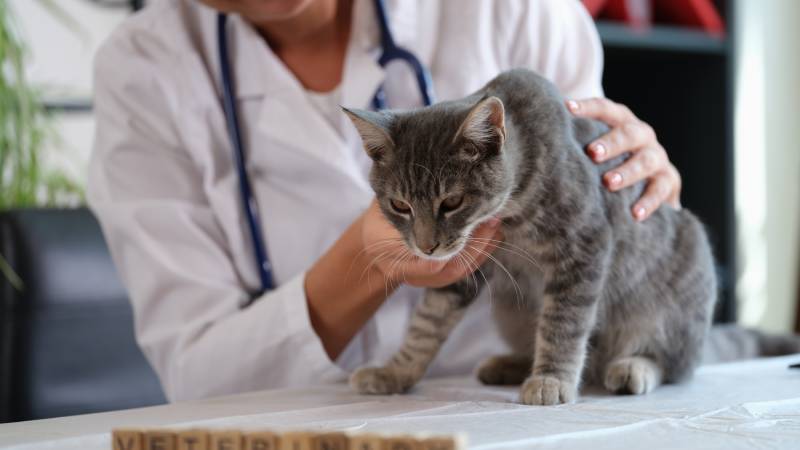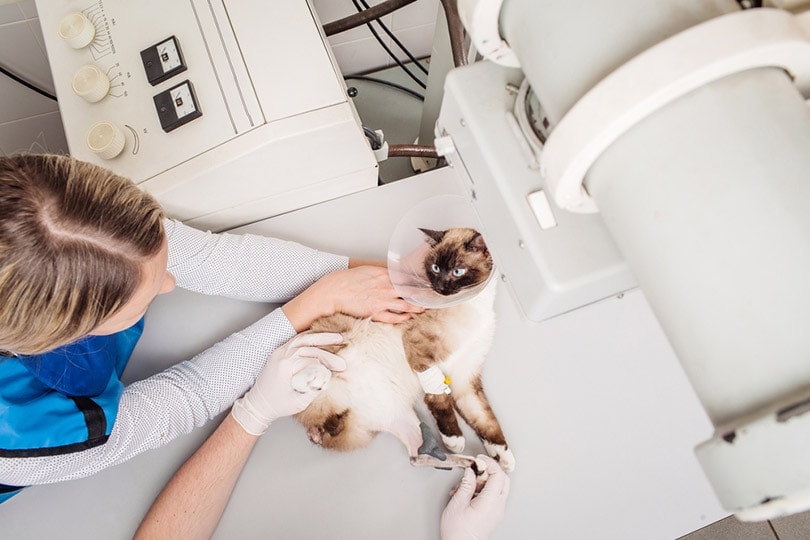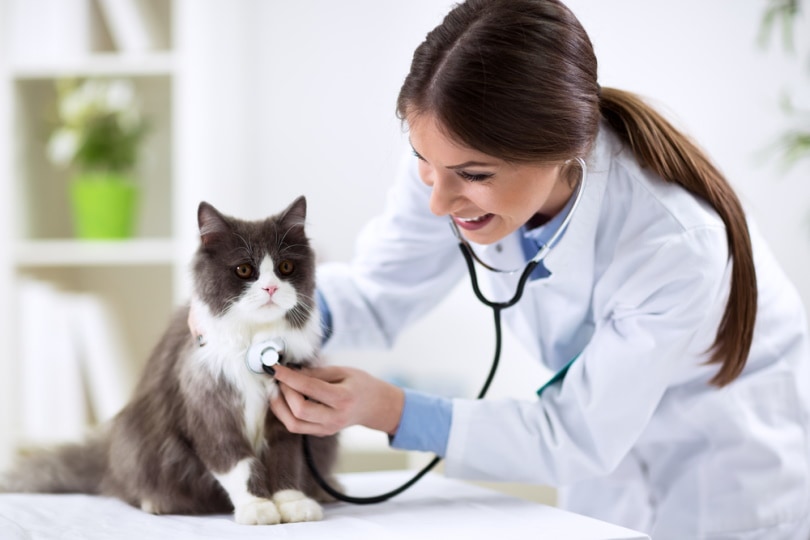
When it comes to pain, your cat is a master of disguise. In the wild, an injured cat has a target on their back, and although your house cat isn’t vulnerable to predators, they instinctively still try their best to hide their pain or illness. Unfortunately, this makes things a bit trickier for cat owners because they have to be extra vigilant, always looking out for telltale signs.
With all this in mind, if your cat has suddenly started limping, it’s natural to feel concerned about it—and you probably should, as they’ll most likely require treatment. Although they may need a bit of pain medication, ointment, or bandaging up, most reasons aren’t serious and usually heal up quickly. For each possible reason, you should always examine your cat’s spine and limbs gently so as not to cause them more pain.
The 9 Possible Reasons Why Your Cat Limping
1. An Injured Paw Pad
You’ll usually be able to distinguish which leg or paw your cat is struggling with quite quickly simply by watching them walk because it’ll be lifted, and they’ll avoid placing any pressure on it. It’s not uncommon for a cat to end up with an injured paw at some point in their life, especially if they frequent the outdoors.
Your cat could be limping due to having something stuck in their paw pad, such as a thorn or piece of glass, or due to a laceration. If your cat landed on something sharp, it could cause them a lot of pain. Thankfully, these types of injuries are easier to see as there may be blood, or you’ll see the thorn or glass when you look at their paw.
Rinse your cat’s foot under water and remove the thorn or glass if it appears very superficial. Hold a cloth to their wound to control the bleeding but if it doesn’t stop within 15 minutes, or if there is a deep wound, it is best to take your cat to the vet.

2. A Torn or Ingrown Nail
You may see similar signs in the way that your cat is walking and limping with an injured claw as you would with an injured paw pad. Whether their nail is torn or ingrown, they’ll be in a lot of pain.
Cats often experience torn nails when their claws are too long as they get stuck in the bark of a tree when climbing or in fabrics when playing. If you have a kitten or a very energetic cat, they could easily lose a nail while darting from one surface to another. Depending on the severity of it, your vet may either remove the whole claw or from the point of the tear.
Ingrown toenails are harder to spot if your cat has long hair, but it can occur when your cat’s claws have grown too long and dig into their paw pads. Their paw pads will bleed, swell, and even ooze pus. Keeping your cat’s nails trimmed is essential.
3. An Insect Sting or Bite
Just like humans, cats are also prone to accidentally stepping on things they shouldn’t, such as bees or wasps. Also, like humans, cats will experience pain and irritation and won’t want to put pressure on the affected area until it’s healed. They’ll probably also have a bit of swelling, but it usually subsides and improves fairly quickly. If you find the stinger in your cat’s paw, remove it to stop the flow of venom and inform your vet.
Unfortunately, bee sting symptoms aren’t always mild as some cats are allergic to them and may experience a more severe reaction than other cats. If your cat breaks out in hives, becomes disorientated, or has diarrhea or vomiting after being stung, they need to be taken to emergency care for treatment.

4. A Sprained, Broken, or Dislocated Leg
If your cat is limping but can place their paw pad on the ground, the pain probably isn’t coming from their paw but higher up along their leg. If your cat had a bad fall, was involved in an accident, or experienced a traumatic injury, they may have a sprained, broken, or dislocated leg. Anything from a ligamentous tear to a fracture may be involved, and it is essential that you take them to be examined by the vet.
If their leg is broken or dislocated, it may look like it’s bent or positioned unnaturally. You may also notice swelling, discomfort in your cat, and cuts or bruising.
5. Patella Luxation
Patella Luxation is a condition that causes your cat’s kneecap to slip out of its natural position and bring discomfort. Patella luxation isn’t unique to a specific breed; however, some breeds are more prone to it. It can also occur due to trauma. More than one kneecap can be affected, with each one at a different grade of severity.
Cats with patella luxation tend to adapt to the condition well and learn how to snap the patella back into place. However, arthritis often develops over time. If your cat occasionally walks strangely, limps, or struggles to jump, they may have been born with patella luxation. You’ll need to take them to be examined by your vet, and they’ll do x-rays. Depending on the severity of your cat’s condition, surgery is often the best treatment.

6. Arthritis
If your senior cat has started limping, avoids jumping, and has become “slower” in their movements, they may have osteorthritis. Unfortunately, this condition is common in older cats and will be one of the first things your vet examines your cat for. It’s painful and uncomfortable, and your cat will require extra care and specialized bedding to take pressure off their joints.
Arthritis commonly affects the joints in a cat’s legs and spine, which is why they tend to limp. Although you may have suddenly noticed your cat limping, the condition does develop gradually. However, as we’ve mentioned, cats are masters of disguise when it comes to pain.
7. Diabetes Mellitus
Diabetes mellitus is a very serious condition that develops when your cat’s body no longer produces insulin the way it should. It usually affects older cats, and many other symptoms will be displayed before it causes your cat to limp. Earlier symptoms are increased urination and thirst, weight loss, and often an increased appetite.
Diabetes also affects your cat’s nerves, which is why they may be limping. They’ll experience pain, weakness, tingling, or numbness in their legs due to the disease. The vet will have to take a blood glucose test which will indicate whether your cat has diabetes or not. The vet will place your cat on treatment and an adjusted diet to keep their blood sugar levels under control.

8. Tumors
If your cat is limping and there are no open wounds, foreign objects, or bleeding, the reason might be more sinister, and there could be a tumor on your cat’s leg bone. A malignant bone cancer known as osteosarcoma can cause pain, stiffness, swelling, lameness, and other symptoms depending on its location in the body. It also has a very high likelihood of metastasis (spreading to other tissue in the body). X-rays and other tests will be needed to rule out this and other tumor types. Your cat will likely require surgery to amputate the affected limb in an effort to control the disease. Although this is an extreme form of treatment, some cats adapt well after surgery and can live relatively normal lives after amputation, pending that it was caught before any evidence of spread.
9. Calicivirus
If your cat has a “cold” or upper respiratory tract infection and has suddenly started limping, they may have calicivirus. This virus will cause many symptoms such as sneezing, eye discharge, mouth ulcers, and fever. However, aggressive strains of the virus can cause pneumonia, organ failure, and joint inflammation, which can result in limping.
The virus is passed through direct contact between one infected cat to another or through objects the infected cat secreted onto from their nose, eyes, or mouth. The vet will diagnose your cat through blood samples, chest x-rays, lab work, and PCR testing. Your cat will need to be isolated and receive treatment but should recover over time.

 When Should They See a Vet?
When Should They See a Vet?
Although you’ll be able to treat your cat from home if the wound or sting is easy to manage with few symptoms, you should always inform your vet. They’ll advise you on what to do if they don’t think it’s serious enough for your cat to be brought in.
If it’s not serious, your vet will often instruct you to rinse your cat’s injured paw under water and wrap it in a bandage to stop the bleeding. They may even tell you to pull the foreign body out of their paw if it’s easily reachable. In these cases, your cat should recover and stop limping quickly.
However, in most of these cases, your cat will require vet care. Although running water over a wound will help, you may still need to take them to be examined by the vet, especially if you can’t stop the bleeding yourself.
If a foreign body is lodged too deeply in your cat’s paw, don’t try to dig it out yourself, as you’ll cause even more pain. If your cat is allergic to bees, don’t hesitate to take them to the vet—it’s better to be sent home than to wait out a severe reaction that could end in fatality.
In cases where there is swelling, a deep wound, distress in your cat, a broken bone, or no other obvious reasons why your cat is limping, take them to the vet. If your cat is limping, there is always a reason for it, even if you can’t identify why.

Conclusion
Whether you know why your cat is limping or not, if it has occurred suddenly, they most likely will need to be seen and treated by a vet. The reasons why they’re limping could range from an ingrown nail to a tumor on their leg bone. Thankfully, in most cases, your cat should recover quickly if they’ve received the right treatment and care.
Featured Image Credit: lagunabluemolly, Pixabay


 When Should They See a Vet?
When Should They See a Vet?



